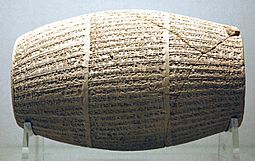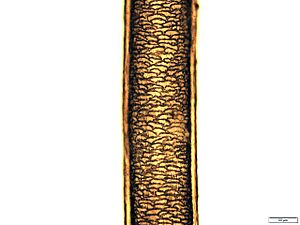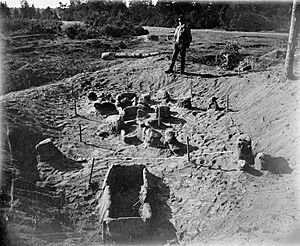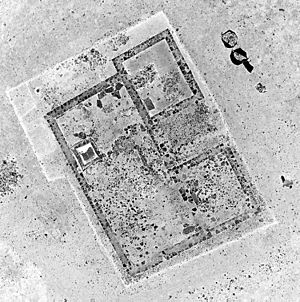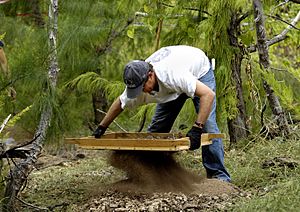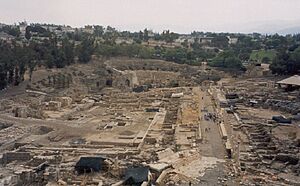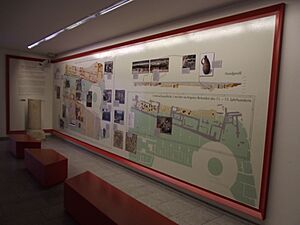Archaeology facts for kids
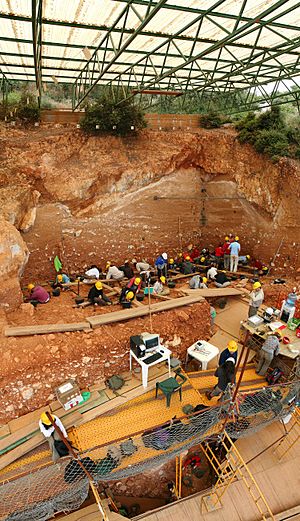
Archaeology is the study of human history through the things people left behind. Archaeologists find and study objects, buildings, and even landscapes to understand how people lived long ago. It's like being a detective for the past! This field is both a social science and a part of the humanities. It helps us learn about human prehistory (before writing) and history, from the first stone tools made 3.3 million years ago to more recent times.
Archaeology is different from palaeontology, which studies fossils of ancient life. Archaeology is super important for learning about societies that didn't have written records. This includes over 99% of human history! Archaeologists want to understand how cultures changed, how people lived, and what happened to human societies over time. The word archaeology comes from Greek and means "the study of ancient history."
This field involves looking for sites (called surveying), digging them up carefully (called excavation), and then studying all the information found. Archaeologists often work with other scientists to get the full picture.
Archaeology grew from "antiquarianism" in Europe in the 1800s. Antiquarians were people who loved old things. Since then, it has become a worldwide study. Today, archaeologists face challenges like fake archaeology, looting of artifacts, and sometimes a lack of public interest.
Contents
History of Archaeology
Early Discoveries
In Mesopotamia, a very old deposit from King Naram-Sin of Akkad (around 2200 BC) was found and studied by King Nabonidus around 550 BC. Because of this, Nabonidus is sometimes called the first archaeologist! He led digs to find old temple foundations and even tried to figure out how old they were. Even though his guess was off by about 1,500 years, it was still amazing for his time, as they didn't have modern dating tools.
Antiquarians and Early Scholars
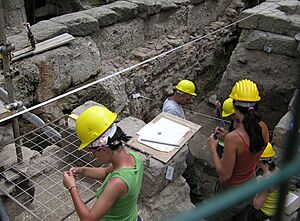

The study of archaeology grew from an older interest called antiquarianism. Antiquarians studied history by looking at old objects, writings, and historical places. They focused on real evidence from the past. In the 17th and 18th centuries, during the Age of Enlightenment, people started to make archaeology more scientific.
In Imperial China, during the Song dynasty (960–1279), scholars like Ouyang Xiu and Zhao Mingcheng studied and saved old bronze objects and their inscriptions. Shen Kuo, another scholar, even criticized others for not understanding the original use of ancient items. These studies were seen as part of Chinese history, not a separate field like archaeology.
In Renaissance Europe, people became very interested in the remains of Ancient Greece and Ancient Rome. Cyriacus of Ancona was an Italian traveler who recorded many ancient buildings, statues, and inscriptions, including the Parthenon and the Egyptian pyramids. He wrote down his discoveries in his diary. Flavio Biondo also created a guide to the ruins of ancient Rome in the 1400s.
In England, antiquarians like John Leland and William Camden surveyed the countryside, drawing and describing old monuments. The word "archaeologist" first appeared in 1824.
First Excavations
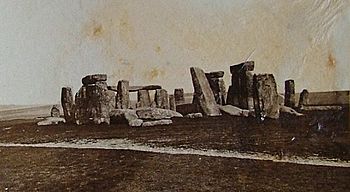
Some of the first archaeological digs happened at Stonehenge and other large stone monuments in England. John Aubrey (1626–1697) was a pioneer who recorded many of these sites. He also tried to understand how styles of writing and architecture changed over time.
Excavations also took place in the ancient Roman towns of Pompeii and Herculaneum, which were buried by a volcano in AD 79. These digs started in the 1700s. Finding whole towns, with tools and even human shapes, amazed people across Europe.
However, early digs were often messy. People didn't understand the importance of layers of soil or the original place of objects.
In the mid-1700s, Johann Joachim Winckelmann from Germany studied Roman antiquities in Rome. He visited the digs at Pompeii and Herculaneum. He helped create scientific archaeology and was one of the first to sort Greek art into different time periods.
Developing Modern Methods
William Cunnington (1754–1810) is called the father of archaeological excavation. He dug in England from 1798, carefully recording Neolithic and Bronze Age burial mounds. Even future U.S. President Thomas Jefferson did his own digs in 1784, using a trench method to study Native American burial mounds.
A big step in the 1800s was understanding stratigraphy. This idea, borrowed from geology, means that different layers of soil represent different time periods. Older things are usually found in deeper layers. Archaeologists like Jacques Boucher de Perthes and Christian Jürgensen Thomsen started to put artifacts in time order.
Augustus Pitt Rivers, an army officer, became a very important figure. He started digging on his land in England in the 1880s. He was very careful and is seen as the first scientific archaeologist. He organized artifacts by type and time, showing how they changed. He insisted that all artifacts, not just pretty ones, should be collected and recorded.
William Flinders Petrie is also called the Father of Archaeology. He carefully recorded and studied artifacts in Egypt and Palestine. He believed in noting and comparing even the smallest details. Petrie created a system for dating layers based on pottery, which changed Egyptology. He was the first to scientifically study the Great Pyramid of Giza in the 1880s. He also trained many Egyptologists, including Howard Carter, who found Tutankhamun's tomb.
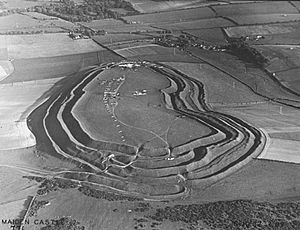
The first widely known dig using stratigraphy was at Hissarlik, the site of ancient Troy, led by Heinrich Schliemann in the 1870s. They found nine different cities built on top of each other. Meanwhile, Sir Arthur Evans's work at Knossos in Crete revealed the amazing Minoan civilization.
Sir Mortimer Wheeler further improved excavation methods in the 1920s and 1930s. He developed the grid system of excavation, which his student Kathleen Kenyon also improved.
Archaeology became a professional job in the early 1900s. You could study it at universities. By the end of the 20th century, most archaeologists had degrees. New types of archaeology developed, like maritime archaeology (underwater) and urban archaeology (in cities). Rescue archaeology also started, where sites are quickly dug before construction destroys them.
Why is Archaeology Important?
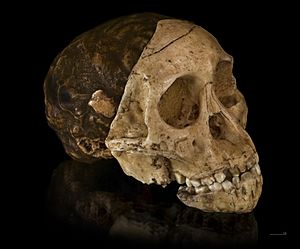
The main goal of archaeology is to learn about past societies and how humans developed. Over 99% of human history happened before writing existed. So, for these prehistoric cultures, archaeology is the only way to understand them. It helps us learn about huge steps in human history, like how humans evolved, how they used fire, made tools, discovered metals, started religions, and began farming. Without archaeology, we would know almost nothing about how people lived before writing.
Archaeology also helps us understand historical cultures that did have writing, like Ancient Greece or Mesopotamia. Their written records are often incomplete or biased. For example, only rich or powerful people might have written things down, and their writings might not show what life was like for everyone else. Archaeology can fill in these gaps and give a more complete picture of society.
Many thousands of cultures and billions of people have lived and died without leaving written records. Writing only appeared around 4000 BC in a few advanced civilizations. But Homo sapiens has been around for at least 200,000 years, and other human-like species for millions! Archaeology is key to understanding these vast periods.
Besides their scientific value, archaeological finds can be important to the descendants of the people who made them. They can also have cultural meaning, or simply be beautiful objects. Some people think archaeology is just about finding treasures, like in movies such as Raiders of the Lost Ark. But modern archaeology is much more about careful study and understanding the past, not just finding valuable items. Unrealistic portrayals are sometimes called "pseudoarchaeology."
Archaeological Methods
An archaeological investigation usually has several steps. First, archaeologists decide what they want to learn. Then, they survey an area to find out as much as possible about it. Next, they might excavate (dig) to uncover things buried underground. Finally, they study the information collected to answer their original questions. It's important to share this information with other archaeologists and historians by publishing it.
Looking from Afar (Remote Sensing)
Before digging, archaeologists can use remote sensing to find sites or learn more about them without touching the ground.
- Lidar: This uses lasers to measure distances and create detailed 3D maps of the ground, even through dense forests. It can reveal hidden structures.
- Laser altimeter: Similar to Lidar, this measures height from an aircraft to map the land's surface.
Searching the Ground (Field Survey)
Archaeologists then do a field survey. This means systematically looking for unknown sites in a region or for specific features (like old houses) within a known site.
Surveying has many benefits. It takes less time and money than digging. It also avoids damaging the site, which is important for ethical reasons and for future study. Surveying is the only way to find out about things like how settlements were spread out. Survey data is often used to create maps showing what's on the surface or where artifacts are found.
The simplest method is a surface survey. People walk across an area, looking for artifacts or features visible on the ground. This can't find things completely buried or covered by plants. Sometimes, small test holes are dug.
Aerial survey uses cameras on airplanes, balloons, or even UAVs (drones). Looking from above helps map large or complex sites quickly. Aerial photos can also show things not visible from the ground. For example, plants growing over a buried stone wall might grow differently. Photos taken at different times of day can show outlines of structures by changes in shadows. Aerial surveys also use ultraviolet, infrared, and ground-penetrating radar.
Geophysical survey is a great way to see underground. Magnetometers detect tiny changes in the Earth's magnetic field caused by iron objects, kilns, or even ditches. Devices that measure the soil's electrical resistivity are also used. Stone or brick structures have higher resistivity, while organic deposits have lower resistivity.
Some archaeologists use metal detectors to find metal objects. This can be helpful, but it's important that detectorists record their finds carefully and don't remove artifacts from their original spot without proper archaeological methods.
For underwater sites, archaeologists use special remote sensing tools like marine magnetometers or side-scan sonar to find shipwrecks or submerged settlements.
Digging Up the Past (Excavation)
Archaeological excavation is where most information comes from. It reveals things you can't see from the surface, like layers of soil (stratigraphy) and the exact location of objects.
Modern excavation means carefully recording the precise location of every object and feature. This is called its provenance. Also, their relationship with nearby objects needs to be recorded. This helps archaeologists figure out which items were used together or belong to different time periods. For example, if a site was lived on by different cultures, artifacts from newer cultures will be above those from older ones.
Digging is the most expensive part of archaeology and it's a destructive process, meaning once you dig, you can't put it back exactly as it was. So, very few sites are dug up completely. Sometimes, large machines like backhoes are used to remove the top layer of soil, but this is done very carefully. After that, the area is usually cleaned by hand with trowels to see all the features clearly.
Archaeologists then draw a site plan. Features dug into the natural soil, like pits or ditches, are usually dug in sections to create a visible archaeological section for recording. A feature has two parts: the cut (the edge of the hole) and the fill (what the hole is filled with). Both are given numbers for recording. Detailed plans, drawings, and photos are taken, and recording sheets are filled out for each context (each layer or feature). All this information creates a permanent record of the site, which is now changed by the digging.
Computers and Drones in Archaeology
Computer graphics are now used to create virtual 3D models of ancient sites, like a Roman city. Photogrammetry (using photos to make measurements) is also used. Computer simulations can help understand how past societies worked.
Drones are becoming very useful for archaeologists. They can quickly survey large areas and create 3D models of sites in days instead of months. Drones can fly at different heights to photograph rooms, whole sites, or even entire valleys. In 2014, drones were used to map the ruins of the Greek city of Aphrodisias in 3D.
Types of Archaeology
Archaeology has many different branches, focusing on specific methods, materials, time periods, or places.
- Historical archaeology studies cultures that had some form of writing. This can include exploring medieval burials or digging up sites from World War II.
- Ethnoarchaeology is the study of living people to help understand the archaeological record. For example, studying how modern hunter-gatherers use tools can help archaeologists understand ancient tool use.
- Experimental archaeology involves trying to recreate ancient technologies or activities. For example, building a replica of an ancient boat to see how it might have sailed.
- Archaeometry uses science from physics, chemistry, and engineering to study archaeological remains. This can involve figuring out what materials artifacts are made of or mapping sites using special tools.
- Cultural resources management (CRM) is a big part of archaeology today. CRM archaeologists work to protect archaeological sites that are threatened by new construction projects, like building roads or cities. They identify, preserve, and sometimes excavate sites before they are destroyed. This helps save much of a nation's history and prehistory.
Protecting Archaeological Sites

Protecting archaeological finds from disasters, wars, and conflicts is very important. Organizations like the United Nations, UNESCO, and Blue Shield International work to protect cultural heritage, including archaeological sites. They emphasize that archaeological finds are part of people's identity, help with tourism, and support economic growth.
Karl von Habsburg, the President of Blue Shield International, said that "Cultural assets are part of the identity of the people who live in a certain place. If you destroy their culture, you also destroy their identity."
Archaeology in Popular Culture
Early archaeology often focused on finding amazing artifacts or exploring mysterious ancient cities. This led to the popular image of archaeologists as "romantic adventurers," like Indiana Jones. Many people think archaeology only happens in faraway lands and is just about finding valuable treasures.
While some important discoveries have been made in dramatic places, most modern archaeology involves careful, detailed work. It's not always as exciting as the movies! Archaeologists often call these unrealistic portrayals "pseudoarchaeology." Archaeologists also rely a lot on public support, and they often discuss who their work is for.
See Also
 In Spanish: Arqueología para niños
In Spanish: Arqueología para niños
- Aerial archaeology
- Anthropology
- Archaeoastronomy
- Archaeobiology
- Archaeogenetics
- Archaeological science
- Archaeology and racism
- Archaeology of religion and ritual
- Archival research
- Area of archaeological potential
- Bioarchaeology
- Chronological dating
- Classical archaeology
- Computational archaeology
- Conservation and restoration of archaeological sites
- Digital archaeology
- Disturbance (archaeology)
- Dump digging
- Environmental archaeology
- Environmental history
- Geophysical survey (archaeology)
- GIS in archaeology
- Glossary of archaeology
- Harris matrix
- Human ecology
- Intellectual Property Issues in Cultural Heritage project
- Landscape archaeology
- Landscape history
- Magnetic survey (archaeology)
- Maritime archaeology
- Nationalism and archaeology
- Palaeoanthropology
- Remote sensing in archaeology
- Urban archaeology
- Zooarchaeology
Lists
- List of archaeological excavations by date
- List of archaeological periods
- List of archaeological sites by country
- List of archaeologists
- List of archaeology awards
- List of paleoethnobotanists


